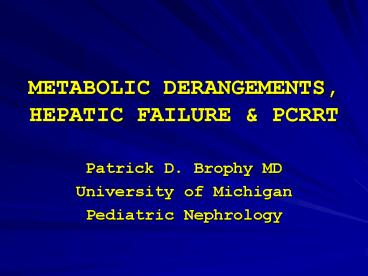METABOLIC DERANGEMENTS, HEPATIC FAILURE - PowerPoint PPT Presentation
1 / 26
Title:
METABOLIC DERANGEMENTS, HEPATIC FAILURE
Description:
Multiple metabolic disorders have been described that are amenable to ... in control of elevated ICP in fulminant hepatic failure (Davenport Lancet 1991:2: ... – PowerPoint PPT presentation
Number of Views:98
Avg rating:3.0/5.0
Title: METABOLIC DERANGEMENTS, HEPATIC FAILURE
1
METABOLIC DERANGEMENTS, HEPATIC FAILURE PCRRT
- Patrick D. Brophy MD
- University of Michigan
- Pediatric Nephrology
2
Objectives
- Metabolic Disorders and Amenability to CRRT
- Hyperammonemia
- Prescription
- Fine points of care
- Combination therapy
- Considerations of CRRT in Hepatic Failure
- Hepatic Insufficiency
- Role of CRRT-bridge to transplant
- Liver support
3
Metabolic Disorders
- Multiple metabolic disorders have been described
that are amenable to various forms of RRT. - Maple Syrup Urine Disease (BCAABuild up lead to
cerebral edema) - Puliyanda et.al. 200217239-242
- Jouvet et.al. 2001271798-1806
- Urea Cycle Defects- hyperammonemia
- Organic Acidemias (accumulation of Acyl Co-A
esters-secondary inhibition of urea cycle enzymes)
4
Hyperammonemia- clinical
- Most Cases develop in neonatal period
- Feeding refusal/intolerance
- Vomiting
- Abnormal muscle tone
- Lethargy
- Seizures
- Coma
- Death
5
Hyperammonemia-etiology
- Urea Cycle Defects
- Carbamyl Phosphate Synthetase (CPS)
- N-acetylglutamate synthetase
- Ornithine Transcarbamylase (OTC)
- Argininosuccinate synthetase (ASA)
- Argininosuccinate Lyase (AL)
- Arginase
6
Hyperammonemia-etiology
- Organic Acidemias
- Propionic Acidemia
- Methylmalonic Acidemia
- Isovaleric Acidemia
- Ketothiolase Acidemia
- Multiple carboxylase deficiency
- Glutaric Acidemia Type II
- 3-Hydroxy-3-methylglutaric acidemia
7
Hyperammonemia-etiology
- Other
- Lysinuric protein intolerance
- Hyperornithinemia-Hyperammonemia-Homocitrullinemia
- Periodic Hyperlysinuria with Hyperammonemia
- Transient Hyperammonemia of the Newborn (THN)
8
Flow Diagram to Evaluate Hyperammonemia
citrullinemia
Sig incr
THN
Nl.
Plasma amino acids
Nl. Or sl. increased
citrulline
ASA
Incr.
ASA
low
Low or absent
CPS
urine
Orotic acid
OTC
Incr.
9
Treatment of HyperAmmonemia
- Aim rapid therapy to prevent permanent brain
damage or death - Prevent further catabolism by providing adequate
calories, fluids and electrolytes - Minimize protein intake
- Provide alternate pathways for ammonia removal
- Sodium benzoate
- Sodium phenylacetate
- Arginine supplementation
10
Mode of RRT
- PD
- Some clearance-but less than optimal
- Too long for optimal removal, may not be able to
keep place with NH4 generation - Hemodialysis
- looks like a good place to start
- Hemofiltration
- a great way to go home at night
11
HD Rx of ammonemia(Gregory et al, Vol. 5,abst.
55P,1994 )
NH4 rebound with reinstitution of HD
NH4 micromoles/l
Time (Hrs)
12
HD to CRRT(prevention of the rebound)
Transition from HD to CVVHD
NH4 micromoles/L
Time (Hrs)
13
Hyperammonemia (McBryde et al, paper in progress)
- 18 children underwent 20 therapies of RRT due to
in-born error of metabolism - mean age 56 7.9 mos
- mean weight 15 3.7 kg (smallest 1.2 kg)
- mean duration of therapy 6.1 1.3 days
14
Hyperammonemia (McBryde et al, paper in progress)
- Modalities used
- HD only-9
- time on HD 2.2 0.9 days
- HF only-3
- time on HF 6.3 2.9 days
- HD followed by HF-8
- time on HD HF 10.25 1.8 days
15
Hyperammonemia (McBryde et al, JASN 2000)
- Outcome
- 12/18 patients survived
- 2/12 continued to be medication and RRT dependent
16
Neonatal Hyperammonemia
- Picca et.al Pediatr Nephrol 200116862-867
- Reviewed prognostic indicators
- CAVHD N4
- CVVHD N4
- HD N2
17
Neonatal Hyperammonemia
- Findings
- NH4 levels decreased with all modalities (1419 to
114 micromoles/L) with CVVHD giving the highest
NH4 clearance HD giving best NH4 extraction
(hemodynamic instability) - 5 had good outcome/5 had poor (not specific to
modality) primarily associated with Coma duration
lt 33 hrs (CNS delay/Death) - Early intervention is key!
18
Hepatic Failure
- Definition Loss of functional liver cell mass
below a critical level results in liver failure
(acute or complicating a chronic liver disease) - Results in hepatic encephalopathy Coma,
Jaundice, cholestasis, ascites, bleeding, renal
failure, death
19
Hepatic Failure
- Production of Endogenous Toxins Drug metabolic
Failure - Bile Acids, Bilirubin, Prostacyclins, NO, Toxic
fatty acids, Thiols, Indol-phenol metabolites - These toxins cause further necrosis/apoptosis and
a vicious cycle - Detrimental to renal, brain and bone marrow
function results in poor vascular tone
20
Hepatic Failure- Role of CRRT
- Objective
- CRRT support can buy time, help prevent further
deterioration/complication and allow - Potential recovery of functional critical cell
mass - Management of precipitating events that lead to
decompensated disease - Bridge to liver transplantation
21
CVVHD for NH4 Bridge to Hepatic Transplantation
Successful Liver Transplantation
NH4 micromoles/L
Time (days)
22
Hepatic Failure-Role of CRRT
- CRRT may not improve overall outcome of liver
failure- but does provide stability and prolongs
life in the setting of hepatic failure - Primary applications include use in control of
elevated ICP in fulminant hepatic failure
(Davenport Lancet 199121604) - Management of Cerebral Edema through middle
molecule removal- reversal of Coma (Matsubara
et.al. Crit Care Med199081331)
23
Hepatic Failure-Role of CRRT
- Improved Cardiac Stability also noted in patients
with Hepatic Renal Failure - IHD vs CAVH vs CAVHD compared
- Noted a decrease in Cardiac Index of 15 in HD
treated patients (also increase in ICP 45 in
HD) - CAVHD/CVVHD- cardiac index decreased by 3 and
no change noted in ICP - Davenport et.al. Crit Care Med 1993 21328-338
24
Hepatic Failure-Role of CRRT
- Others
- Fluid Balance
- Nutritional support
- Uremic Clearance
25
Future Horizons
- Currently Undergoing Clinical Evaluation
- Liver Assist Devices several companies (ie
MARS- Molecular Adsorbents Recycling System) - Both Biological and non- biological systems (ie
porcine hepatocytes/hemodialysis
filters/hemofilters - Engage principles of both convection and
diffusion (ie albumin dialysate) and anionic
trapping with charcoal regeneration chambers for
albumin - Huge potential Impact on critical care
Transplantation!
26
(p. brophy)
- ACKNOWLEDGEMENTS
- MELISSA GREGORY
- ANDREE GARDNER
- JOHN GARDNER
- THERESA MOTTES
- TIM KUDELKA
- LAURA DORSEY BETSY ADAMS































